Global coral bleaching event hits St.Vincent and the Grenadines.
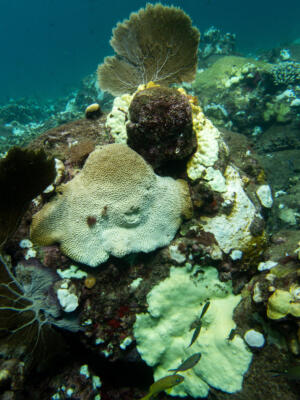
By Louise Mitchell, executive director, St. Vincent and the Grenadines Environment Fund
November 16th, 2023
In St. Vincent and the Grenadines, we have witnessed an alarming change in coral reefs
between August 2023 and October 2023, in the form of a massive bleaching event
unprecedented in our lifetime.
During these couple of months above average temperatures led to a heating up of the
ocean that caused our corals to literally go into shock. Global warming has increased water
temperatures (and also caused our sea levels to rise). Scientists are now saying that the last
12 months was the hottest period that humanity has lived through in 125,000 years with
2023 being the hottest year in human history after 5 months of consecutive record-breaking
temperatures. (Climate Central reports on CNN)
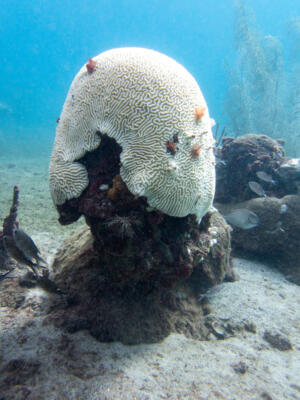
I started scuba diving in 1986, and since then I have done 501 dives and even more snorkeling trips, most of which were in Bequia and the Grenadines. Never in my history of diving or snorkeling have I come across any form of devastation to the corals as I have witnessed with my own eyes just recently.
Two years ago, Blue Marine Foundation came to SVG at the invitation of local partners, SVG Environment Fund (SVGEF) and the Ministry of Fisheries. While here, they documented that some of the most diverse and vibrant coral reefs in the entire country were found along the Leeward coast of St. Vincent. These corals were pristine as they were not impacted by anchor damage or the pollution from high yachting and other marine tourism activities found in the Grenadines.

Not anymore. Even the Leeward coast has been devastated by coral bleaching.
The heatwave caused a massive bleaching event that has affected almost every species of coral on the reefs, ranging from the hard brain corals, to elkhorn and staghorn corals to the soft corals.
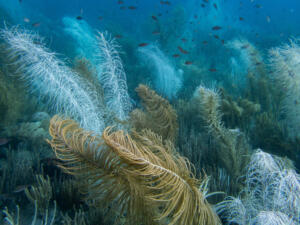
Interestingly, a few corals have not been badly affected by the coral bleaching. These are nobby brain corals, seafans and sea rods. Sponges, which can also be impacted by bleaching events were not seen to be affected during this period including tube, barrel and encrusting sponges.
Environmental organisations over the years have supported the propagation of corals through coral nursery programmes. The first such programme was started in Mustique in 2014 under the leadership of the then head of the Mustique Environmental Committee, Bryan Adams.
However, while these programmes were deemed necessary in the light of the general decline of coral reefs, none of us imagined that we would see such a massive bleaching event in our lifetimes as the one we have just witnessed with this year’s heatwave.
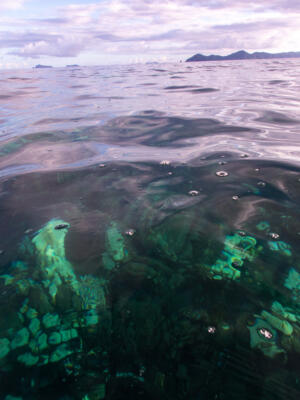
The St Vincent and the Grenadines Environment Fund members Stephan Hornsey, Lisa Gaymes, Ashford Richards and I, conducted an investigative snorkel from villa beach to the back of Young Island and around Fort Duvernette, up to the navigation marks and then back along the east coast of Young Island and back over to the beach at Mariners. We documented the coral reefs via photography which I share with you here in the photos below (together with explanatory captions), all photos taken Oct. 24, 2023.
The photos show the undisputed fact that most of our corals have been bleached in the last two months alone. This is known because had dived these waters in July this year and the contrast is shocking. Coral reefs, while comprising less than 1% of the ocean floor, are the habitats for 25% of the ocean’s fish and other species. The loss of coral life equates directly to the loss of fish and correspondingly to the drastic decline of the fisheries industry. Perhaps you have noticed fewer fish in the fish market recently.
What is important from a scientific perspective is to see which corals are affected and which aren’t. In our propagation programmes going forward, we need to pay more attention to propagate the more resilient corals if our reefs are to survive the growing impacts of the changing climate and rising sea temperatures.
Also, most of the corals in nurseries have all been bleached in the recent bleaching event. What this means is that for future programmes, the nurseries will have to be placed in deeper waters (present nurseries tend to be in waters about 15-20 feet deep), as well as to have a land-based system to protect the corals in the event of an extreme heat wave such as the one experienced this year.
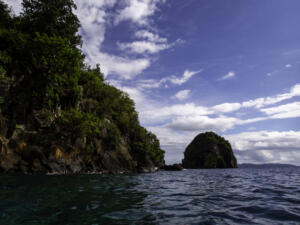
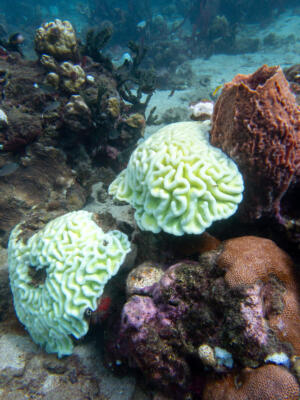
The bleaching of coral occurs when coral loses its colour and appears white or whitish. Coral is a living organism made up of thousands of polyps, which form a symbiotic relationship with the algae (called zooxanthellae) that live in them to survive. Coral bleaching is a defensive mechanism wherein the polyps expel the algae when the coral becomes stressed due to the harmful conditions being faced. Corals can survive a bleaching event, but are more susceptible to disease and have lost its major source of food (which is produced by the algae). If the harmful conditions (rise in ocean temperature) do not improve, and the algae, do not come back to recolonize the coral within a few months, the coral will starve and then die. The act of bleaching itself does not mean that the coral is dead. It does mean that it is in danger of dying. With the cooling of temperatures, it can become healthy again.
According to Cathy Sachs, dive instructor at Dive Bequia since 1995, in addition to the coral bleaching which has impacted corals nationwide, the Grenadines was struck since January 2023 by another problem, the stony coral tissue loss disease (SCTLD). A disease which apparently can be treated by antibiotics, although no such treatment has been approved or used in SVG. As a result, many corals in the Grenadines died in 2023.
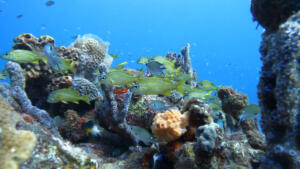
Environmental problems require collective action. Climate change is a clear threat to human survival. The most direct impact of coral bleaching is the loss of the habitat for fish, which can devastate our fishing stock. Fish may become a rare delicacy should these events of bleaching continue, and the fishing industry could be decimated. Imagine the impact on lives and livelihoods if this happens. What is for certain now is that our coral reefs are in peril and so is the future of our fisheries. Time for collective action is now. Drastic actions are needed to reduce the pace of the rise of global temperatures, it’s now no longer a distant concern, it is hitting us hard and fast.
Coral bleaching also suggests a very hard time ahead in scuba diving tourism. Who can take a paying visitor out to see a dead reef with almost no fish? Scuba instructors are being asked to play a greater and greater role in ocean science, creating coral nurseries and fully engaging in the fight to save our coral reefs. Dive Bequia’s present coral nursery at Devils Table, Bequia has taken a major hit from the recent bleaching event, but they remain ever committed to continuing the efforts to save our reefs.

Reports show that this massive bleaching event between August and October of this year has happened across the Caribbean, from the Florida Keys in the north to Curacao in the south.
To mitigate the forces that are pushing the earth in a certain direction we must have a framework of cooperation in the Caribbean and the world.
Steps to be taken locally to mitigate the damage caused to reefs by coral bleaching:
- Support coral propagation nurseries both in the ocean and on land
- Support regrowth of the reef by not killing parrot fish which clean the reefs (and which are protected in law)
- Support regrowth of the reef by not killing tiny reef fish
- Plant mangroves and shoreline trees, to reduce soil runoff, so as to not further place reefs in danger due to silk run-off
- Lower your personal carbon footprint (reduce, reuse, recycle)
Without a doubt, these local efforts must be coupled with a global effort to take drastic measures to quickly slow down the pace of global warming. Protecting species that sequester carbon dioxide, such as whales, is needed now more than ever. Trees also absorb carbon dioxide and for every tree that is cut one should be planted. Countries must move quickly to phase out fossil fuels usage and embrace green energy solutions. An ocean that is too hot cannot sustain life.
Do your part, plant a tree today, invest in the planet beyond your lifetime.
All photos taken by Stephan Hornsey, SVGEF (dates on all photos Oct. 24, 2023 unless otherwise stated)

